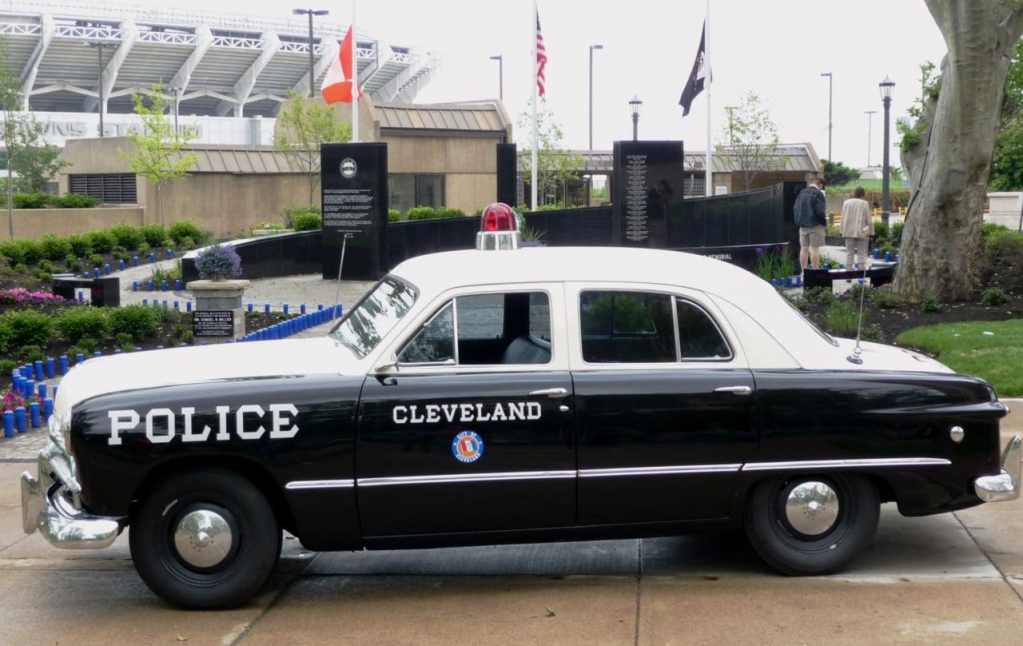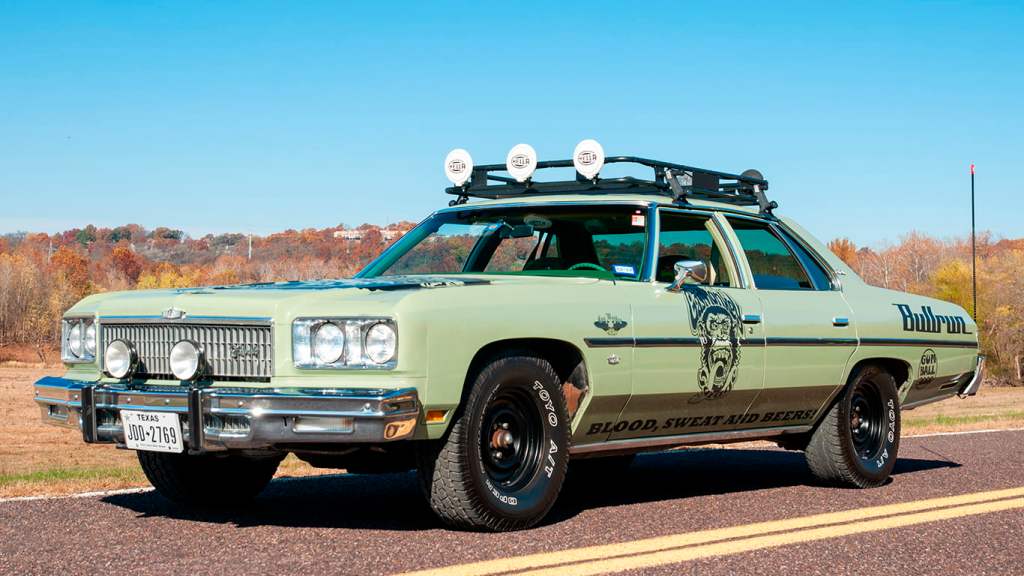The Po-Po. Their job is to protect and serve, it says so right on the side of their cruisers. Their cruisers come decked out with ballistics to protect the occupants from just about every imaginable situation, all while having some of the latest technology and features to enhance the driving experience during a long day on duty.
So, that got us thinking? How have police cars changed and adapted over time? How did they go from electric wagons 100 years ago to hybrid cruisers with fully autonomous driving capabilities? Yes, that means autonomous police vehicles could enforce traffic laws very soon That’s a scary thought that may be coming sooner than you think!
Buckle up your handcuffs and let’s go!
The Beginning – No More Horses

So, where did it all start? It was 1899 in Akron, Ohio, where crimes were happening all around town. And instead of having to call officers placed around the city, they devised that their officers should be mobile. So, they had the Collins Buddy Company make them a car for around $2,400, which is about $65,000 in today’s money!
It was powered by two 4-horsepower electric motors, giving them an impressive top speed of 16 miles per hour and a range of about 30 miles. Criminals stood no chance! This was the first-ever horseless police vehicle ever used in the USA. And because they were going to be capturing a bunch of criminals, they added a cell for captured inmates with room for up to 12 people, which was a massive improvement from the horse-drawn carriages they had before.
This allowed a squad of officers to be mobile and made other cities notice too. This led to a chain of cities getting their own patrol cars, such as New York and their fleet of Radio Motor Patrol Vehicles in 1920.
The 1920s – New York, New Cars

The fleet of vehicles that New York got in the 1920s made it so that officers were able to deploy officers to problemed areas much quicker. And with a police car and a radio, a single officer could cover an area that would have previously needed several officers.
This not only allowed response time to be shortened but also made it so that less officers were needed to cover the same area. That saved jurisdictions money and proved effective at capturing criminals, especially during the Prohibition era, until the criminals decided to get faster cars that could outrun police cars.
So, what did that mean for the cops? They had to upgrade too, and their upgrade came from Ford with the introduction to the flathead V8.
The 1930s – Ford’s Flatheads

In 1932, Ford unveiled the flathead V8 Model 8 as an affordable vehicle with surprising performance for the time, so much so that the police used cars with this engine for over 30 years! The engine was capable of making more power than most cars on the road, all while being able to keep the price low, which made the Ford flathead V8 a real possibility for police all across the States.
Not only did the police like the flathead V8s, but the criminals did too! They would take their flatheads and soup them up, making them into lethal hot rods! Bonnie and Clyde, among others, used these powerhouses to try and outrun the police, and it worked for a while, until about the ’40s when the Big Three started making police packages.
The 1940s – The Big Three

Just about every police car in the 1940s was coming out of Detroit from the Big Three: Ford, Chevrolet, and Chrysler. As the cops ordered more and more cruisers, the auto manufacturers started to notice a pattern. Most police cars left their factories with similar options.
So, that left them thinking, what if they could make a package with all those options on their specific cars? And not long after, all three manufacturers started offering police packages on their cars coming with big engines and the most robust drivetrains.
This allowed the cops to be a leg ahead once again! That is, up until the criminals souped up their cars to outrun the cops again. So, who did the police turn to? Plymouth.
The 1960s – Po-Po Power

Plymouths used Chryslers V8s, and those V8s put out a ton of power for the time, enough power to keep up with the criminals. The 440-cubic-inch V8 paired with Chrysler’s TorqueFlite transmissions gave these Plymouth boats plenty of power to take down the criminals, and they also added torsion bar suspensions to give them an advantage in the corners too!
Speed was the name of the game, and Plymouth had the recipe nailed. Not only were they powerful but they were proven reliable too, which was important for every officer on the force.
Things changed, though, after the OPEC oil crisis. The police weren’t enthralled with the massive power of honking V8. Instead, they wanted something smaller and more efficient, but could still get the job done.
The police then went away from their Chrysler and Plymouth cruisers and went with smaller Chevy Caprice and Ford LTD models.
The 1970s – Efficient Enforcement

Not only were smaller cars better on gas, but they also accelerated faster, handled better, and even stopped quicker. So, while Ford and Chevy decided to downsize, Chrysler continued to make big cars.
The Ford LTD was the less powerful of the two with its bigger 5.8-liter engine putting out only 142 horsepower. The Chevy Caprice came with a 5.7-liter V8, but it put down 170 buff horses. Even then, both cars underperformed the cars they were replacing. Why? Well, because the big Plymouths were putting down 375 horsepower! That was more than double that of either of the new cars.
The next few decades after the oil crisis was resolved saw many police cars coming out of the Big Three. Most came and went, but there was one that stayed in the game for decades until it was terminated in 1996, the Chevy Caprice.
The 1990s – Copper Caprice

For decades, the Chevy Caprice was the backbone for a lot of police, but just like The Office being on Netflix. All good things must come to an end. The Caprice was discontinued in 1996, which opened the door to its main competitor, the Ford Crown Victoria.
The Crown Vic – The Golden Age

The fight between the Crown Vic and the Caprice was close in the ’90s up until Chevy canned the Caprice program in 1996. Sure, other manufacturers tried to make a rival to the Crown Vic, but Ford’s cop car dominated the police car market.
Many of these tanks can be found still rolling around with 200,000 or even 300,000 miles or more. Police officers liked the Crown Vic because it shared a lot with the Mustang GT of the time, so parts were plentiful and relatively cheap to fix. Cops would run their cruisers into the ground, then taxi companies would turn them into cabs even after years of active duty on the police force. If that’s not a testament to its reliability, I don’t know is.
When selling their cruisers, instead of buying a different car, police would likely go out and buy another Crown Vic! They dominated police car sales throughout the country and nothing could touch them until they were discontinued.
Discontinued – The King Is Dead

The reign of the Ford Crown Victoria had to come to an end sometime, and Ford thought that 2011 should be the year. With aging parts and old technologies, Ford decided to take a different approach with a newer car, the Taurus.
However, the other manufacturers of the Big Three both wanted to get back into the police car segment too. Dodge rolled out a new Charger Police Vehicle and Chevy revived the Caprice, and the race was on!
The New Arms Race – Things Get Interesting

In one corner, we had the defending champ Ford with their new Taurus. And competing against the current champion were both Dodge and Chevy. Each of the three had a very unique and different take on what a new era police car should be.
Ford based their new cruiser on the existing Taurus platform, calling their new car the Ford Police Interceptor Sedan. They took the aluminum block V6 directly out of the Mustang and stuffed it into the engine bay. This V6 was good for 305 horsepower, all while returning pretty decent gas mileage. You could also get the twin-turbo EcoBoost 3.5-liter V6 pumping out a respectable 365 horsepower.
Both engines were offered with all-wheel drive, which was better for any road conditions throughout the country. Unlike the outgoing Crown Victoria, the Police Interceptor Sedan came with a load of safety features not even available on the Crown Vic like a blind spot monitoring system, a rearview camera, and specialty-tuned traction control for emergency-style driving.
After hearing the Crown Vic was getting decommissioned, Chevy had to step up, and they came in strong. They not only brought back a name synonymous with police cars, but they also based it on the Australian Holden police car. The Caprice Police Patrol Vehicle or “PPV” received perfect scores from the Los Angeles County Sheriff’s Department, only being slightly knocked for its overly cautious traction control. Sounds like Chevy could learn a thing or two from Ford.
The Chevy Caprice PPV came with an LS V8 or a high-revving V6 for better fuel economy. While the Caprice PPV wasn’t as highly optioned as the Ford Police Interceptor Sedan, it was still a solid competitor.
The Dodge Charger Pursuit also made some waves in the game. Like the Caprice PPV, the Charger Pursuit was offered with a more efficient V6 and a more powerful V8 model. But, unlike the standard car, the Pursuit version came with bigger brakes as well as a few other features to make it a bigger nightmare for people trying to outrun the coppers.
An all-wheel drive option became available on the V8-equipped models and with it, they had an active transfer case that allowed them to disconnect the front axle from the powertrain to aid in maneuverability and make the car a bit more playful.
In 2012, just one year after the Crown Vic was discontinued, the Dodge Charger Pursuit became the #1 police sedan in the states, but the all-wheel drive Ford Explorer Interceptor became the go-to police SUV.
The New Rides – Hot Fuzz

Both the Dodge Charger Pursuit and the Ford Explorer Interceptor dominate police forces around the country today. From small towns to big cities, you’re sure to find some of these wheels rolling around. These are the red-and-blues flashing around catching the bad guys and maniacs who continue to terrorize our streets.
The cops have chosen both these cars for their combination of power, economy, and utility, as they rise above what all their competitors put out. Let me tell you, even with the base 3.6-liter in the Dodge Charger Pursuit, chances are that you’re not getting away, because it packs 300 ponies under the hood. Pretty impressive, if you ask me.
But, what’s even more impressive is the optional 5.7-liter Hemi V8 with 395 pound-feet of gut-wrenching torque and 370 horsepower. Try to outrun that and you’ll be left with a hefty ticket or even behind bars.
You’d expect that out of a police car, right? But what about an SUV? Well, the 3-liter EcoBoost engine on the Ford Explorer Interceptor puts out an impressive 400 horsepower and 415 pound-feet of torque! No one’s getting away now.
But, if you’re worried about the gas mileage on the big turbo EcoBeast, then you might want to opt for the 3.3-liter hybrid version that comes standard with 23 miles per gallon in the city and an even better highway rating.
So, it’s fair to say that present-day cop cars are at the highest point they’ve ever been. They’re the most powerful, the most efficient, and definitely the most prepared that squad cars have ever been. And, of course, the Po-Po will continue to up their game for decades to come, with Ford patenting an autonomous police vehicle that will give you zero ways to flirt your way out of a ticket!
The craziest part is that they wouldn’t necessarily even pull you over, they would issue the traffic citation wirelessly because newer cars are able to communicate with one another. We’re all screwed!






Leave a Reply
View Comments